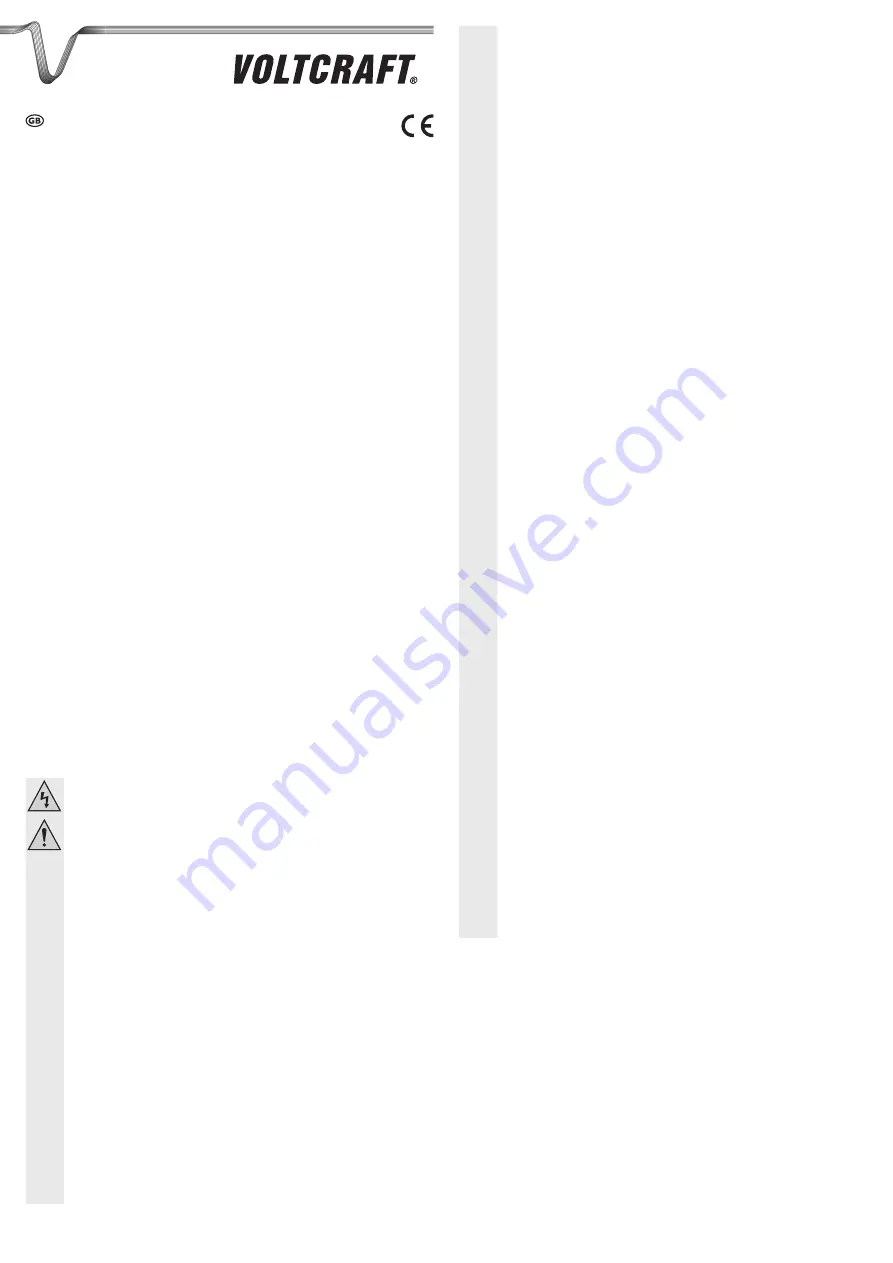
OPERATING INSTRUCTIONS
VERSION 09/11
100 - 240 V/AC QUICK CHARGER 1 / 2 A
ITEm NO.: 23 78 51
INTENDED USE
The device serves to charge Ni-Cd / NiMH accumulator packs with a cell count of
5 to 8. This corresponds to a charging voltage of 7 - 11.2 V. The charging current
can be adapted to the respective accumulator in two stages (1000 mA / 2000 mA).
There is a discharge function for Ni-Cd accumulators to prevent the memory effect.
After the accumulator is discharged, the quick charger automatically switches to
charge mode. The intelligent minus delta V charge cutoff detects a full accumulator
and automatically switches to “trickle charge”. The accumulator is not overcharged
and retains its charge status. A LED provides information about the current operating
status.
A protective cut-off automatically interrupts the charging process after 6 hours. A
longer charging time most often indicates a defect accumulator. The connections can
be exchanged on the charger depending on the applied accumulator system. The
charger may only be connected an operated with 100 - 240 V alternate current.
For safety and approval purposes (CE), you must not rebuild and/or modify this
product. If you use the product for purposes other than those described above, the
product may be damaged. In addition, improper use can cause hazards such as
short circuiting, fire, electric shock etc. Read the instructions carefully and keep
them. Make this product available to third parties only together with its operating
instructions.
DELIVERy CONTENT
Charger
•
Tamiya plug
•
Alligator clip
•
Round 5.5 mm hollow plug
•
Key
•
Operating instructions
•
SAfETy INSTRUCTIONS
Read the operating instructions carefully and especially observe the
safety information. If you do not follow the safety instructions and
information on proper handling in this manual, we assume no liability
for any resulting personal injury or damage to property. Such cases
will invalidate the warranty/guarantee.
Persons / Product
a)
The product is not a toy and should be kept out of reach of children!
•
When used in conjunction with other devices, observe the operating
•
instructions and safety notices of connected devices.
The product must not be subjected to heavy mechanical stress.
•
The product must not be exposed it to extreme temperatures, direct
•
sunlight, intense vibration, or dampness.
The plug-type charger is protected against overload and short-circuiting.
•
Observe the polarity at the charge output!
Do not leave chargers or accumulators unattended when in operation.
•
The construction corresponds to protection class II (double or reinforced
•
insulation). Ensure that the insulation (of the housing or the main cable) is
neither damaged nor destroyed.
In commercial institutions, the accident prevention regulations of the
•
Employer’s Liability Insurance Association for Electrical Systems and
Operating Materials are to be observed.
In schools, training centres, hobby and self-help groups, the use of
•
chargers and accessories should be closely supervised by trained
personnel.
Avoid using the appliance under unfavourable ambient conditions.
•
Otherwise the sensitive electronic parts inside of the charger risk being
damaged, and could be life threatening to the user. Adverse ambient
conditions are:
Excess air humidity (> 75 % rel., condensing)
-
Dampness
-
Dust and inflammable gases, vapours or solvents, petrol
-
Excessive ambient temperatures (> ap prox. +40°C)
-
Strong vibrations
-
In the case of incorrect handling (excessive charging current or incorrect
•
polarity), the accumulator can be overcharged or destroyed. In the worst
case, the accumulator could explode and cause considerable damage.
Keep transmitting devices (mobile telephone, transmitting systems for
•
model making etc.) away from chargers as the transmitter signal could
interfere with charging and possibly break the charger and thus the
accumulator.
Never connect your charger to the mains immediately after it has been
•
taken from a cold room to a warm one. The resulting condensation could,
under adverse circumstances, destroy the appliance. Allow the device tor
each room temperature before switching it on.
If you have reason to believe that the device can no longer be operated
•
safely, disconnect it immediately and secure it against being operated
unintentionally. It can be assumed that safe operation is no longer
possible if:
the device is visibly damaged,
-
it does not function any longer
-
if it has been stored for long periods of time under unfavourable
-
conditions
if it has been subject to considerable stress in transit.
-
(Rechargeable) batteries
b)
Correct polarity must be observed while inserting the (rechargeable)
•
batteries.
(Rechargeable) batteries should be removed from the device if it is not
•
used for a long period of time to avoid damage through leaking. Leaking
or damaged (rechargeable) batteries might cause acid burns when
in contact with skin, therefore use suitable protective gloves to handle
corrupted (rechargeable) batteries.
(Rechargeable) batteries must be kept out of reach of children. Do not
•
leave (rechargeable) batteries lying around, as there is risk, that children
or pets swallow them.
All (rechargeable) batteries should be replaced at the same time.
•
Mixing old and new (rechargeable) batteries in the device can lead to
(rechargeable) battery leakage and device damage.
(Rechargeable) batteries must not be dismantled, short-circuited or
•
thrown into fire. Never recharge non-rechargeable batteries. There is a
risk of explosion.
miscellaneous
c)
Consult an expert when in doubt about operation, safety or connection
•
of the device.
Maintenance, modifications and repairs are to be performed exclusively
•
by an expert or at a qualified shop.
If you are not sure about the correct connection or use, or if questions arise which
are not covered by these operating instructions, please do not hesitate to contact our
technical support or another qualified specialist.
Voltcraft®, Lindenweg 15, D-92242 Hirschau, Tel. +49 180/586 582 7.
CONNECTION
When connecting accumulators, always observe the charging instructions of the
1.
accumulator manufacturer concerned.
Use the enclosed key to set the charging current.
2.


























